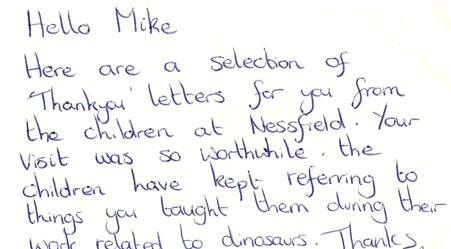When is an Iguanodon Not an Iguanodon?
Yesterday, Everything Dinosaur reported on the discovery of a giant whale tooth found in Beaumaris Bay (Victoria). This significant fossil find, once again highlighted the importance of amateur fossil hunters when it comes to contributing to the Earth Sciences. You don’t have to travel all the way to Australia to play your part, sometimes the geological collection housed at your local regional museum can provide an opportunity for you to make you mark.
Take for example, the vertebrate fossil collection at Dorking Museum and Heritage Centre. Student Tom Fedrick has helped re-classify dinosaur tail bones originally described as belonging to an Iguanodon, but keen-eyed Tom, using knowledge gained from four years volunteering at the Museum, concluded that a centrepiece of the collection represented the bones of an entirely different, albeit related dinosaur – Mantellisaurus.
The Caudal Vertebrae on Display (Mantellisaurus atherfieldensis)
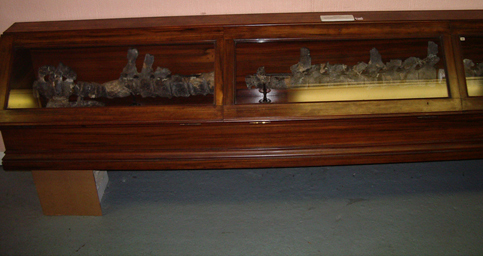
On display at the museum.
Picture credit: Dorking Museum and Heritage Centre
Digitalising the Dorking Museum Collection
Much of the fossil collection is currently being catalogued digitally. This will enable the collection to be accessed by other museums, researchers and academics. A-level student Tom has been working on this substantial project and having completed work on around half of the collection, he turned his attention to the Iguanodon exhibit.
Tom explained:
“Looking at it [the Iguanodon exhibit] in the past I always thought it was odd, thinner than I would expect. However with the catalogue entry in front of me my suspicions were confirmed: this was not an Iguanodon. Though it was listed as Iguanodon atherfieldensis my background knowledge meant I knew that this species had been reclassified as a new genus entirely – Mantellisaurus by Gregory Paul in 2007.”
Tom Fedrick and the Re-classified Dinosaur Bones (Mantellisaurus atherfieldensis)
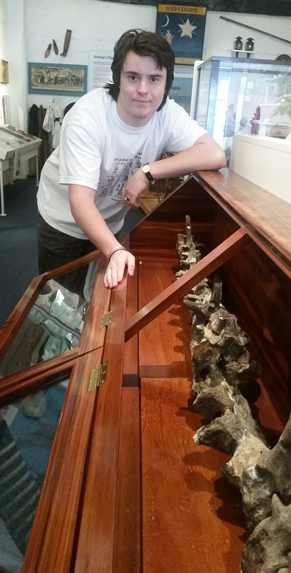
Tom, a student at Reigate Grammar School oversees the cataloguing of the dinosaur bones.
Picture credit: Dorking Museum and Heritage Centre
The Problem with Iguanodontids
The fragmentary nature of iguanodontid fossils excavated from various locations across the south of England have presented palaeontologists with a number of taxonomic puzzles to solve. Iguanodon was the second dinosaur species to be named and described (although the genus name was erected before the Order Dinosauria had been established). Gideon Mantell named Iguanodon, but at the time his paper was published, he failed to establish a holotype or indeed assign a trivial name to his specimen. From that point on, the Iguanodon genus became a sort of dumping ground for any large Ornithischian dinosaur fossil material excavated from the Weald Clay Formations and the contemporaneous Wessex Formation of the Isle of Wight.
A spokesperson from Everything Dinosaur commented:
“It’s complicated! Lots of fossils found in Europe, Africa and North America formerly ascribed to Iguanodon, have been re-classified since the turn of the Century. The holotype material for Iguanodon bernissartensis for instance, a genus synonymous with the term “English dinosaur”, has been reassigned to more complete Belgian fossil material and we congratulate Tom for spotting the incorrectly labelled museum specimen.”
Mantellisaurus
Mantellisaurus atherfieldenis was established in 2007 by the American Gregory Scott Paul. It is a more gracile animal than the robust Iguanodon bernissartensis and considerably smaller, perhaps around seven metres in length. Analysis of the forelimbs suggest that Mantellisaurus spent the majority of its time as a biped, although it could adopt a four-legged stance when desired (facultative quadruped).
Comparing Iguanodontid Skeletons (after Gregory S. Paul)
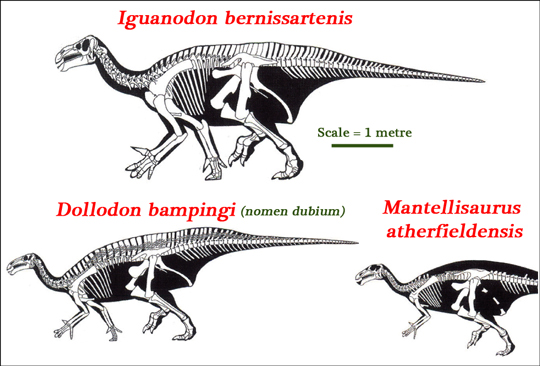
Iguanodontid comparisons. D. bampingi is regarded as Nomen dubium.
Picture credit: Gregory S. Paul with additional annotation by Everything Dinosaur
The picture above compares the skeletons of three types of iguanodontids. Although, Gregory S. Paul regarded Dollodon bampingi as a valid genus, more recent research suggests that Dollodon might be a synonym of Mantellisaurus. The term “Nomen dubium” is given to any organism whose validity is in doubt.
A Model of Mantellisaurus atherfieldenis
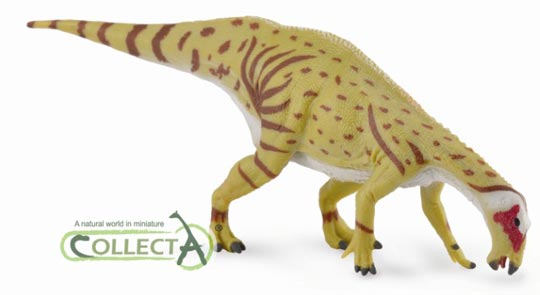
CollectA Mantellisaurus drinking.
For models and replicas of iguanodontids: CollectA Age of Dinosaurs Popular Models.
Digitised Dinosaur
This is the second time that a fossil specimen has been reclassified after research undertaken at the Dorking Museum and Heritage Centre. Last year, Everything Dinosaur reported upon the reclassification of a marine reptile specimen, thought to have represented Polyptychodon interruptus.
To read this article: Pliosaur Skull Links Dorking to Kansas.
The programme of digitally logging the collection at the Dorking Museum and Heritage Centre is progressing. It is thanks to dedicated, hard-working individuals that our country continues to be blessed with a wealth of regional museums which contribute so much to our understanding of the world
Dorking Museum opening times: Thursday, Friday and Saturday, 10am – 4pm.
Admission: Adults £2, Concessions £1, Under-5s free, Family ticket £4.50 (prices correct at time of publication)
For more information on this fascinating regional museum visit: Dorking Museum and Heritage Centre.


